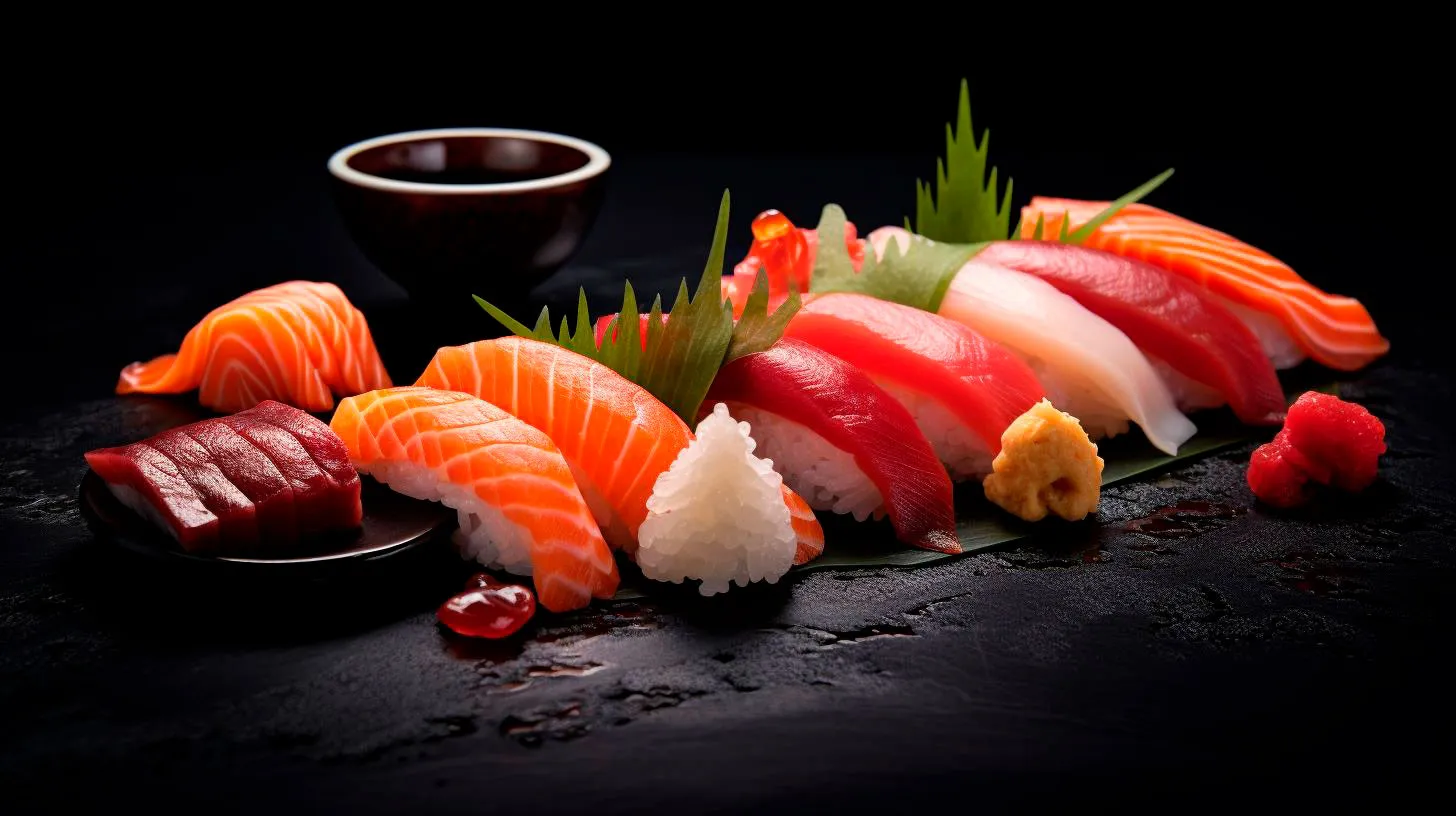Revolutionizing the Seafood Industry: Innovations for Sustainable Sushi
Fortunately, technological advancements and innovative practices are emerging to revolutionize the seafood industry, ensuring a more sustainable future for sushi lovers worldwide.
The Current State of the Seafood Industry
The seafood industry is facing significant challenges due to the increased demand for sushi. Overfishing has led to the depletion of certain fish populations and disrupted marine ecosystems. According to the United Nations’ Food and Agriculture Organization (FAO), over 90% of the world’s marine fish stocks are now fully exploited or overfished. This alarming statistic calls for immediate action to prevent irreversible damage to our oceans.
The Need for Sustainability
Sustainability is the key to ensuring the longevity of the seafood industry. It involves finding ways to meet current seafood demands without compromising the ability of future generations to meet their own needs. By adopting sustainable practices, the seafood industry can contribute to the conservation of marine ecosystems, protect endangered species, and promote ethical fishing practices.
Innovations in Sustainable Sushi
Revolutionary innovations are emerging to address the sustainability challenges faced by the sushi industry. These innovations not only promote environmental conservation but also enhance the overall dining experience. Let’s explore some of the key innovations that are revolutionizing the sushi industry:
- Aquaculture: Aquaculture, or fish farming, is rapidly gaining popularity as a sustainable solution. It involves cultivating fish in controlled environments, reducing the pressure on wild fish populations. With advances in aquaculture technology, sushi restaurants can now source their seafood from sustainable fish farms, ensuring a steady supply of high-quality fish.
- Traceability: Ensuring the integrity and sustainability of seafood products is crucial. Innovations in traceability technologies, such as blockchain, enable consumers to track the entire journey of their sushi, from the ocean to their plate. This transparency promotes responsible fishing practices and helps combat seafood fraud.
- Plant-based Alternatives: Plant-based alternatives are gaining traction in the sushi industry. Companies are developing plant-based substitutes for traditional sushi ingredients like fish and crab meat. These alternatives not only reduce the pressure on fish populations but also cater to the increasing demand for vegetarian and vegan options.
- Reducing Food Waste: Food waste is a significant issue within the seafood industry. Innovative solutions are being developed to reduce waste and ensure a sustainable supply chain. For example, surplus fish can be transformed into other seafood products like fish cakes or fish balls, reducing the need for additional fishing.
- Education and Awareness: Raising awareness about sustainable seafood is crucial for driving industry-wide change. Sushi restaurants can play a vital role in educating their customers about the importance of choosing sustainable options and the impact of their choices on the environment. Promoting sustainable seafood certifications, such as the Marine Stewardship Council (MSC) label, can also guide consumers towards sustainable choices.
The Advantages of Sustainable Sushi
Embracing sustainable practices in the sushi industry brings numerous benefits that go beyond environmental conservation:
- Long-term Availability: By preserving fish populations and protecting marine ecosystems, sustainable sushi ensures a long-term supply of seafood, preventing the extinction of certain species.
- Supporting Local Communities: Sustainable fishing practices can benefit local communities by providing employment opportunities, promoting economic growth, and preserving cultural traditions.
- Healthier Seafood: Sustainable fishing methods often result in higher-quality seafood, free from harmful chemicals and antibiotics, making it a healthier choice for consumers.
- Enhancing Reputation: Businesses that embrace sustainability not only attract environmentally conscious customers but also gain a competitive edge and enhance their brand reputation.
Key Takeaways
The sushi industry is at a crossroads, facing significant sustainability challenges. However, innovative technologies and practices are revolutionizing the seafood industry, paving the way for a more sustainable future. By embracing aquaculture, enhancing traceability, promoting plant-based alternatives, reducing food waste, and raising awareness, the sushi industry can thrive while ensuring the longevity of our oceans. Sustainable sushi not only benefits the environment but also offers advantages such as long-term availability of seafood, support for local communities, healthier choices for consumers, and enhanced brand reputation. Let’s embark on this journey towards a more sustainable and delicious sushi experience!
Sustainable Sushi: Eco-Friendly Dining Goes Beyond the Plate
This article explores the importance of eco-friendly dining, the benefits of sustainable sushi, and key takeaways for individuals looking to make a positive difference.
The Importance of Eco-Friendly Dining
Eco-friendly dining goes beyond satisfying our taste buds; it takes into account the entire lifecycle of food, from production to disposal. By opting for sustainable practices, we contribute to the preservation of ecosystems, promote biodiversity, and reduce carbon emissions. As the food industry strives to become more sustainable, sushi restaurants have an essential role to play.
Key Takeaway: Eco-friendly dining supports environmental preservation and reduces the carbon footprint of the food industry.
The Benefits of Sustainable Sushi
Sustainable sushi practices prioritize the use of responsibly sourced seafood, reducing the negative impact on marine ecosystems. Here are some compelling advantages of embracing sustainable sushi:
- Preserving Fish Stocks: Sustainable sushi focuses on using abundant, well-managed fish populations, contributing to their conservation.
- Protecting Marine Ecosystems: Sustainable practices minimize the damage to marine habitats and the bycatch of endangered species.
- Supporting Local Communities: By choosing sustainably sourced sushi ingredients, you promote local fishermen and sustainable fishing practices.
- Ensuring Food Safety: Sustainable sushi promotes transparency in the seafood supply chain, reducing the risks of foodborne illnesses.
- Consumer Demand: Opting for sustainable sushi encourages the industry to adopt more environmentally friendly practices, ultimately leading to a more sustainable food system.
Key Takeaway: Sustainable sushi protects fish stocks, preserves marine ecosystems, supports local communities, ensures food safety, and influences the industry towards better practices.
The Road to Sustainable Sushi
Transitioning to sustainable sushi practices requires collaboration between sushi restaurants, their suppliers, and consumers. The following initiatives can drive this positive change:
- Responsible Sourcing: Sushi restaurants can partner with suppliers that prioritize sustainable fishing methods and adhere to responsible sourcing standards.
- Menu Diversification: Expanding the sushi menu to include sustainable alternatives such as plant-based options reduces reliance on fisheries.
- Waste Reduction: Implementing waste reduction strategies like proper portioning, recycling, and composting help reduce the environmental footprint of sushi restaurants.
- Customer Education: Sushi restaurants can educate consumers about sustainable choices through menu descriptions, table displays, or website content.
- Certifications and Labels: Displaying sustainable seafood certifications and eco-labels provides transparency and reassurance to customers.
Key Takeaway: Collaboration between sushi restaurants, suppliers, and consumers is essential in adopting sustainable sushi practices.
Statistical Highlights
Let’s take a look at some industry statistics that shed light on the significance of sustainable sushi:
- According to the United Nations, over 90% of the world’s fish stocks are fully exploited, overexploited, or depleted.
- The Marine Stewardship Council’s Chain of Custody certification has been awarded to over 1,800 businesses worldwide since its inception in 1997.
- In 2020, the US seafood market witnessed a 41% increase in retail sales of certified sustainable seafood products.
Key Takeaway: The statistics highlight the urgent need for sustainable sushi practices to protect fish stocks and the significant impact businesses can make by adopting responsible sourcing.
Conclusion
Sustainable sushi is a vital step towards a greener and more responsible food industry. By embracing eco-friendly dining practices, we contribute to the conservation of marine ecosystems, support local communities, and inspire positive changes in the seafood supply chain. Let’s make a difference one sushi roll at a time!
From Farm to Table: The Ethical Journey of Sushi Ingredients
In this article, we will explore the importance of sourcing sustainable and ethically produced ingredients for sushi, shedding light on the impact it has on both the environment and our conscience. Let’s dive in!
The Sustainable Seafood Movement
A vital aspect of sushi is the seafood that adorns each roll or nigiri. Traditionally, sushi features fish varieties like tuna, salmon, and shrimp, among others. However, overfishing and destructive fishing practices have led to significant threats to marine ecosystems and fish populations. That’s why the sustainable seafood movement has gained traction over the years, emphasizing responsible fishing and aquaculture practices.
Here are some key takeaways related to sustainable seafood:
- Sustainable seafood ensures the long-term health of marine ecosystems and species.
- Look for sushi establishments that source their seafood from sustainable suppliers.
- Support initiatives like the Monterey Bay Aquarium’s Seafood Watch program, which provides guidelines for sustainable seafood choices.
The Rise of Organic and Local Produce
While seafood takes center stage in sushi, let’s not forget the role of vegetables and other ingredients that contribute to its flavors and textures. With the growing popularity of organic and locally sourced produce, sushi connoisseurs are increasingly demanding high-quality ingredients that align with their sustainable and ethical values.
Consider these key points regarding the rise of organic and local produce in sushi:
- Organic vegetables and fruits used in sushi reduce exposure to harmful pesticides and chemical fertilizers.
- Local sourcing supports local farmers and reduces the carbon footprint associated with long transportation distances.
- Seek sushi restaurants that prioritize organic and/or locally sourced ingredients.
The Impact of Sustainable Packaging
Aside from the ingredients themselves, sushi enthusiasts are showing increasing concern over the packaging used for takeout orders and dine-in experiences. Plastic waste and non-recyclable materials have been plaguing the planet, causing immense harm to wildlife and ecosystems. As a result, sustainable packaging solutions have become a point of focus for eco-conscious sushi lovers.
Let’s consider the significance of sustainable packaging in the sushi industry:
- Sustainable packaging includes alternatives like biodegradable containers, compostable utensils, and recyclable materials.
- Choose sushi establishments that prioritize sustainable packaging practices.
- Opt for takeout options with minimal packaging and bring your reusable utensils to reduce waste.
The Importance of Transparency
One of the cornerstones of ethical sushi sourcing is transparency. Sushi enthusiasts want to know the story behind their food, including where the ingredients come from, how they were produced, and the impact their choices have on the environment. Sushi restaurants that embrace transparency earn the trust and loyalty of customers seeking sustainable and ethically sourced meals.
Consider these key aspects related to transparency in sushi sourcing:
- Choose sushi establishments that disclose their sourcing practices, such as partnerships with sustainable seafood suppliers or organic farms.
- Be wary of restaurants that cannot provide information on the origin or sourcing of their ingredients.
- Support establishments that prioritize transparency and are willing to engage in a dialogue about their sourcing methods.
Conclusion
Sourcing ethical ingredients for sushi is not only a matter of taste and quality but also a responsibility towards the planet. By supporting sustainable seafood, organic and local produce, and environmentally friendly packaging, we can ensure that sushi retains its appeal while minimizing its ecological footprint. Let’s be conscious consumers and make thoughtful choices when enjoying this beloved culinary delight. Remember, from farm to table, every step counts!
Awareness and Action: How Individuals Can Support Ocean-Friendly Dining
In this article, we will explore what ocean-friendly dining entails and provide valuable insights into how individuals can actively participate in preserving our precious marine resources.
Understanding Ocean-Friendly Dining
Ocean-friendly dining refers to a set of practices and choices that help safeguard the oceans and marine life. It involves making conscious decisions in terms of seafood consumption, sustainable fishing practices, and promoting responsible choices throughout the food industry.
By adopting ocean-friendly dining practices, individuals can ensure that their food choices align with the well-being of the oceans. This means supporting sustainable fisheries and reducing the impact of overfishing, reducing plastic pollution, and minimizing the carbon footprint associated with the production and transportation of food.
Key Takeaways for Ocean-Friendly Dining
- Choose sustainable seafood: Opt for seafood that is caught or farmed sustainably. Look for certifications such as the Marine Stewardship Council (MSC) label, which ensures the seafood is sourced responsibly.
- Support local and seasonal produce: Consuming local and seasonal produce reduces the carbon footprint associated with transportation and supports the local economy.
- Reduce plastic waste: Avoid single-use plastics like straws, cutlery, and plastic bottles. Instead, use reusable alternatives such as metal straws and refillable water bottles.
- Be mindful of food waste: Minimize food waste by planning meals, storing leftovers properly, and composting organic waste. Food waste contributes to greenhouse gas emissions and strains marine ecosystems.
- Spread awareness: Educate others about the importance of ocean-friendly practices. Share your knowledge on social media, join community groups, or volunteer for organizations that promote sustainable dining.
The Advantages of Ocean-Friendly Dining
Ocean-friendly dining offers numerous benefits, both for individuals and our planet:
- Preserving marine biodiversity: By supporting sustainable seafood choices, we can protect various species and their habitats, playing a vital role in preserving the delicate balance of marine biodiversity.
- Improving food security: Sustainable fishing practices ensure the long-term availability of seafood, supporting food security for present and future generations.
- Reducing pollution: By minimizing plastic waste and choosing eco-friendly alternatives, we can significantly reduce pollution in our oceans, contributing to cleaner and healthier marine ecosystems.
- Mitigating climate change: Sustainable food choices reduce greenhouse gas emissions associated with the food industry, helping combat climate change and its impact on oceans.
- Supporting local communities: Embracing local and seasonal produce supports local economies and helps build resilient communities that are less dependent on imported goods.
Ocean-Friendly Dining: A Collective Responsibility
Protecting our oceans is a shared responsibility that involves actions and awareness at all levels. While government regulations and policies play a crucial role, individual efforts also contribute significantly to transforming the food industry and promoting sustainable practices.
By being conscious of our food choices and encouraging others to adopt ocean-friendly dining habits, we can create a positive impact on our planet. Together, we can ensure the health and sustainability of our oceans for generations to come.
In conclusion
Ocean-friendly dining is not a trend but a necessity for a sustainable future. By making simple yet impactful changes in our dining choices and spreading awareness, we can actively participate in safeguarding our oceans and supporting marine life. Let’s embrace ocean-friendly dining, one plate at a time, and inspire others to join the movement.


